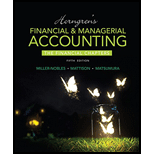
Concept explainers
1.
No-par
Common stock: These are the ordinary shares that a corporation issues to the investors in order to raise funds. In return, the investors receives a share of profit from the profits earned by the corporation.
Par value: It refers to the value of a stock that is stated by the corporation’s charter. It is also known as face value of a stock.
To Journalize: the issuance of common stock for Incorporation W.
To Journalize: the issuance of no-par preferred stock for Incorporation W.
To journalize: the purchase of land in exchange common stock issuance by Incorporation W.
2.
To Prepare: the stockholders’ section of the
Want to see the full answer?
Check out a sample textbook solution
Chapter 13 Solutions
Horngren's Financial & Managerial Accounting, The Financial Chapters Plus MyAccountingLab with Pearson eText -- Access Card Package (5th Edition)
- A fixed asset with a cost of dollar 42,200 and accumulated depreciation of dollar 36,500 is sold for dollar 9,850. What is the amount of the gain or loss on disposal of the fixed asset?arrow_forwardNeed help with this financial accounting questionarrow_forwardTICA Corporation had sales of $72 million this year. Its accounts receivable balance averaged $2.4 million. How long, on average, does it take the firm to collect on its sales? Help mearrow_forward
- Principles of Accounting Volume 1AccountingISBN:9781947172685Author:OpenStaxPublisher:OpenStax College
